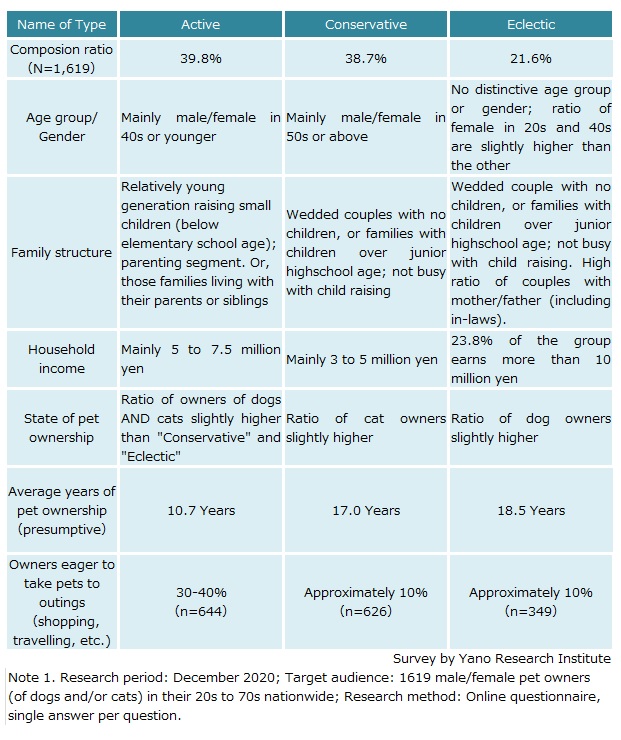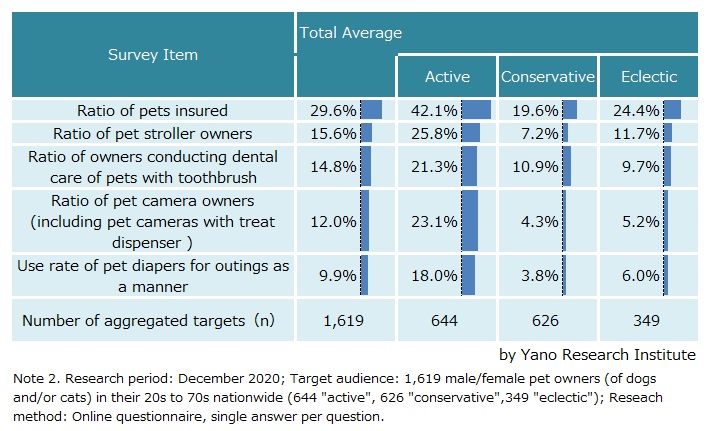No.2664
Consumer Survey on Pet Owners Consumption Activities in Japan: Key Research Findings 2020
Keen Owners that Accounts for 40% of All Pet Owners are Main Prospects of New Pet Products and Services
Yano Research Institute (the President, Takashi Mizukoshi) has carried out a consumer survey on pet owners (of dogs and/or cats) in Japan, classified the pet owners into 3 groups by hierarchical cluster analysis, and analyzed the characteristics of each groups. This press release covers a part of the analysis results.


Summary of Research Findings
This survey was carried out in December 2020 on 1,619 male and female pet owners (owners of dogs and/or cats) in their 20s to 70s (age and gender roughly in even distribution) nationwide. Analysis of the survey is based on 3 groups (“active”, “conservative”, and “eclectic (somewhat ‘active’ and somewhat ‘conservative’ )”) derived from the hierarchical cluster analysis*, based on the attributes of target pet owners (6 attributes including age group, gender, family structure, household income, and years of ownership) and on response to questions regarding their life with pets (17 questions including one asking if they go for a walk/shop/travel/eat out with pets, and one asking if they post pet photos on SNS).
The analysis results revealed that the pet owners can be classified roughly into 40 percent of “active” owners and 40 percent of “conservative” owners. Consumers that belong to the “active” group are mainly in their 40s or younger, parenting children below elementary school age, and have been pet owners for 10 years in average. Out of this group, 30 to 40 percent are keen to take their pets to outings (i.e. shopping, travelling, etc.). On the other hand, main segments of the “conservative” group are chiefly in their 50s or above, with children above junior high school age and not busy with child raising, and the average years of pet ownership is 17 years. Out of this group, approximately 10 percent are eager to take their pets to outings (to shopping or to travelling, etc.).
*Hierarchical cluster analysis is one of the multivariate analysis methods, an analytical method for identifying homogeneous clusters from the bulk of cases with miscellaneous characteristics.
Noteworthy Topics
“Active” Pet Owners Shifting Their Perception from ‘Owning Pets’ to ‘Living with Companion Animals’
Although pet owners currently do not have much demand for pet supplies and services such as pet insurance, pet strollers, dental care for pets using toothbrush, pet cameras (including those with treat dispenser feature) and pet diapers (for the use during outings as a manner), demand for these markets are expected to expand going forward as the pet owners are shifting their perception from ‘owning pets’ to ‘living with companion animals as a family member or a partner’.
According to the analysis results, 42.1% of the pets owned by “active” pet owners are insured, while it was only 29.6% among all pets of questionnaire respondents. Similarly, 25.8% of the “active” owners possess pet strollers, 21.3% have done dental care for pets using toothbrush, 23.1% owns pet cameras (including those with treat dispensing feature), and 18.0% uses pet diapers during outings as a manner. All of the percentages (percentage of possession/execution/use) for “active” group exceeded those of “conservative” group and “eclectic (somewhat active and somewhat conservative)” group.
Based on the survey result, it is assumed that the “active” pet owners are keen on new information, and tend to be interested in, and willing to, adopt new things.
For launching new products and services in the pet-related product/service market, it is necessary to develop a strategy to deliver a right message to the “active” pet owners.
Research Outline
2.Research Object: 1,619 male and female pet owners (owners of dogs and/or cats) in their 20s to 70s nationwide
3.Research Methogology: online survey (questionnaire)
This survey (survey on consumption activities of pet owners) was carried out in December 2020 to 1,619 male and female pet owners (owners of dogs and/or cats) nationwide in their 20s to 70s (age and gender roughly in even distribution). In this research, pet owners are classified into 3 groups (“Active”, “Conservative”, and “Eclectic (Active and Conservative)”) by hierarchical cluster analysis*, based on attributes of target pet owners (6 attributes including age group, gender, family structure, household income, and years of ownership) and on their response to questions regarding their life with pets (17 questions including one asking if they go for a walk/shop/travel/eat out with pets, and one asking if they post pet photos on SNS). Through this analysis, the survey aims to find out the potential consumption behavior of pet owners that is closer to actual situation.
*Hierarchical cluster analysis is one of the multivariate analysis methods, an analytical method for identifying homogeneous clusters from the bulk of cases with miscellaneous characteristics.
<Products and Services in the Market>
Pet food, pet supplies (potty pads for dogs, sand for cats' toilet, pet diapers, dental care items for pets, etc.), pet related services (insurance for pets).
Published Report
Contact Us
The copyright and all other rights pertaining to this report belong to Yano Research Institute.
Please contact our PR team when quoting the report contents for the purpose other than media coverage.
Depending on the purpose of using our report, we may ask you to present your sentences for confirmation beforehand.